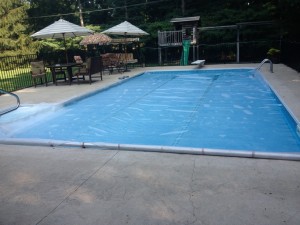 A normal evaporation rate will depend on the surface area of the pool, the temperature fluctuations of the pool water and the air temperature thorough the day and night, the humidity, and the wind. Water loss due to splash out or wind will depend on any water features that you may have, and any areas where water is raised and falling back into the pool where wind could pick it up just a bit. People and pets playing in the pool will also cause some of your water loss through normal splashing and swimming activity.
A normal evaporation rate will depend on the surface area of the pool, the temperature fluctuations of the pool water and the air temperature thorough the day and night, the humidity, and the wind. Water loss due to splash out or wind will depend on any water features that you may have, and any areas where water is raised and falling back into the pool where wind could pick it up just a bit. People and pets playing in the pool will also cause some of your water loss through normal splashing and swimming activity.
If you are losing more than .25″ of water a day, and have to add water to your pool every few days that would be more than normal – unless you are in the middle of summer in the hottest part of the desert – then that much may be normal!
One municipal water district predicts that water loss of 200-300 gallons per week for a medium-sized pool — about 2%-5% of typical pool volumes in southern states.
To determine your rate of evaporation in your back yard you can do a simple bucket test:
To perform the bucket test:
- Take a 5-gallon bucket and make a mark with a permanent marker at about the halfway point. Fill the bucket with (pool water so it’s the same temperature) water up to that point, and set the bucket right beside your swimming pool. Simultaneously, use a pencil to mark the water level on your pool tile. In that way, your can determine how much water has evaporated from the bucket and from the pool. **If you are running your heater continually during this process, and your air temperature is causing steam to billow off your pool this will not be an accurate way to measure your evaporation.
If you are looking for complicated:
- The evaporation rate of water from a swimming pool is fairly easy to calculate; given you have access to a psychometric chart or a water vapor tables. W=(A (69.4+30.8 (V)) / Y )(Pw-Pa) W = lb / hr of evaporation. A = surface area of the swimming pool. V = mean wind velocity (mph). Y= Latent heat (approx. 1000). Pw – Sat. Press at Room Air temp (in Hg). Pa – Sat. Vapor press at water temp (in Hg)
A few fun facts:
- You will lose more water in the spring and fall than in the middle of summer. When water temperatures warm up during the day and cool significantly at night just watch the steam rising. (I often visualize this as $$ signs floating right out of the pool.)
- Liquid Solar Blankets and actual solar blankets are a great way to prevent a significant amount of evaporation.
- A call to your local pool professional to troubleshoot your questions may help give you an idea what is normal for your area.
- Leak detection experts can use equipment to locate and find leaks through the use of underwater microphones and other technical equipment.
